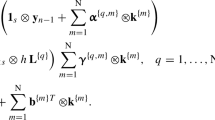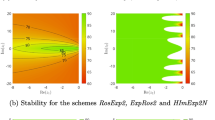Abstract
This work considers multirate generalized-structure additively partitioned Runge–Kutta methods for solving stiff systems of ordinary differential equations with multiple time scales. These methods treat different partitions of the system with different timesteps for a more targeted and efficient solution compared to monolithic single rate approaches. With implicit methods used across all partitions, methods must find a balance between stability and the cost of solving nonlinear equations for the stages. In order to characterize this important trade-off, we explore multirate coupling strategies, problems for assessing linear stability, and techniques to efficiently implement Newton iterations for stage equations. Unlike much of the existing multirate stability analysis which is limited in scope to particular methods, we present general statements on stability and describe fundamental limitations for certain types of multirate schemes. New implicit multirate methods up to fourth order are derived, and their accuracy and efficiency properties are verified with numerical tests.



Similar content being viewed by others
Availability of Data and Material
The implementation of the CUSP problem is available in ODE Test Problems: https://github.com/ComputationalScienceLaboratory/ODE-Test-Problems.
References
Alexander, R.: Diagonally implicit Runge–Kutta methods for stiff ODEs. SIAM J. Numer. Anal. 14(6), 1006–1021 (1977). https://doi.org/10.1137/0714068
Andrus, J.: Stability of a multi-rate method for numerical integration of ODEs. Comput. Math. Appl. 25(2), 3–14 (1993)
Ascher, U.M., Ruuth, S.J., Spiteri, R.J.: Implicit-explicit Runge–Kutta methods for time-dependent partial differential equations. Appl. Numer. Math. 25(2), 151–167 (1997). https://doi.org/10.1016/S0168-9274(97)00056-1
Bartel, A., Günther, M.: A multirate W-method for electrical networks in state-space formulation. J. Comput. Appl. Math. 147(2), 411–425 (2002). https://doi.org/10.1016/S0377-0427(02)00476-4
Beam, R.M., Warming, R.: An implicit finite-difference algorithm for hyperbolic systems in conservation-law form. J. Comput. Phys. 22(1), 87–110 (1976). https://doi.org/10.1016/0021-9991(76)90110-8
Bonaventura, L., Casella, F., Delpopolo, L., Ranade, A.: A self adjusting multirate algorithm based on the TR-BDF2 method. (2018). arXiv preprint arXiv:1801.09118
Constantinescu, E., Sandu, A.: Multirate timestepping methods for hyperbolic conservation laws. J. Sci. Comput. 33(3), 239–278 (2007). https://doi.org/10.1007/s10915-007-9151-y
Constantinescu, E.M., Sandu, A.: Extrapolated multirate methods for differential equations with multiple time scales. J. Sci. Comput. 56(1), 28–44 (2013). https://doi.org/10.1007/s10915-012-9662-z
Carciopolo, L.D., Bonaventura, L., Scotti, A., Formaggia, L.: A conservative implicit multirate method for hyperbolic problems. Comput. Geosci. (2018). https://doi.org/10.1007/s10596-018-9764-2
Gear, C.: Multirate methods for ordinary differential equations. Tech. rep., Illinois Univ., Urbana (USA). Dept. of Computer Science (1974)
Gear, C.W., Wells, D.: Multirate linear multistep methods. BIT Numer. Math. 24(4), 484–502 (1984)
Günther, M., Hoschek, M.: ROW methods adapted to electric circuit simulation packages. J. Comput. Appl. Math. 82(1–2), 159–170 (1997). https://doi.org/10.1016/S0377-0427(97)00043-5
Günther, M., Rentrop, P.: Multirate ROW methods and latency of electric circuits. Appl. Numer. Math. 13(1), 83–102 (1993). https://doi.org/10.1016/0168-9274(93)90133-C
Günther, M., Sandu, A.: Multirate generalized additive Runge–Kutta methods. Numer. Math. 133(3), 497–524 (2016). https://doi.org/10.1007/s00211-015-0756-z
Hachtel, C., Bartel, A., Günther, M., Sandu, A.: Multirate implicit Euler schemes for a class of differential-algebraic equations of index-1. J. Comput. Appl. Math. p. 112499 (2019). https://doi.org/10.1016/j.cam.2019.112499
Hairer, E., Wanner, G.: Solving ordinary differential equations II: stiff and differential-algebraic problems, 2 edn. No. 14 in Springer Series in Computational Mathematics. Springer, Berlin (1996)
Hairer, E., Wanner, G., Lubich, C.: Geometric Numerical Integration. Springer, Berlin (2006). https://doi.org/10.1007/3-540-30666-8
Hundsdorfer, W., Savcenco, V.: Analysis of a multirate theta-method for stiff ODEs. Appl. Numer. Math. 59(3–4), 693–706 (2009). https://doi.org/10.1016/j.apnum.2008.03.022
Kennedy, C.A., Carpenter, M.H.: Additive Runge–Kutta schemes for convection–diffusion–reaction equations. Appl. Numer. Math. 44(1), 139–181 (2003). https://doi.org/10.1016/S0168-9274(02)00138-1
Knoth, O., Wolke, R.: Implicit-explicit Runge-Kutta methods for computing atmospheric reactive flows. Appl. Numer. Math. 28(327–341) (1998)
Kværnø, A.: Stability of multirate Runge-Kutta schemes. Int. J. Differ. Equ. Appl. 1(1) 97–105 (2000)
Kværnø, A., Rentrop, P.: Low order multirate Runge-Kutta methods in electric circuit simulation, Preprint 99/1. University of Karlsruhe, IWRMM, Karlsruhe (1999)
Peaceman, D.W., Rachford Jr., H.H.: The numerical solution of parabolic and elliptic differential equations. J. Soc. Ind. Appl. Math. 3(1), 28–41 (1955). https://doi.org/10.1137/0103003
Ralston, A.: Runge–Kutta methods with minimum error bounds. Math. Comput. 16(80), 431–437 (1962). https://doi.org/10.2307/2003133
Rice, J.R.: Split Runge–Kutta methods for simultaneous equations. J. Res. Natl. Inst. Stand. Technol. 60 (1960)
Roberts, S., Popov, A.A., Sandu, A.: ODE test problems: a MATLAB suite of initial value problems. arXiv preprint arXiv:1901.04098 (2019). https://github.com/ComputationalScienceLaboratory/ODE-Test-Problems
Roberts, S., Sarshar, A., Sandu, A.: Coupled multirate infinitesimal GARK schemes for stiff systems with multiple time scales. SIAM J. Sci. Comput. 42(3), A1609–A1638 (2020). https://doi.org/10.1137/19M1266952
Rodríguez-Gómez, G., González-Casanova, P., Martínez-Carballido, J.: Computing general companion matrices and stability regions of multirate methods. Int. J. Numer. Methods Eng. 61(2), 255–273 (2004)
Sand, J., Skelboe, S.: Stability of backward Euler multirate methods and convergence of waveform relaxation. BIT Numer. Math. 32(2), 350–366 (1992)
Sandu, A.: A class of multirate infinitesimal GARK methods. SIAM J. Numer. Anal. 57(5), 2300–2327 (2019). https://doi.org/10.1137/18M1205492
Sandu, A., Günther, M.: A generalized-structure approach to additive Runge–Kutta methods. SIAM J. Numer. Anal. 53(1), 17–42 (2015). https://doi.org/10.1137/130943224
Sarshar, A., Roberts, S., Sandu, A.: Design of high-order decoupled multirate GARK schemes. SIAM J. Sci. Comput. 41(2), A816–A847 (2019). https://doi.org/10.1137/18M1182875
Savcenco, V.: Comparison of the asymptotic stability properties for two multirate strategies. J. Comput. Appl. Math. 220(1–2), 508–524 (2008)
Savcenco, V.: Construction of a multirate RODAS method for stiff ODEs. J. Comput. Appl. Math. 225(2), 323–337 (2009). https://doi.org/10.1016/j.cam.2008.07.041
Savcenco, V., Hundsdorfer, W., Verwer, J.: A multirate time stepping strategy for stiff ordinary differential equations. BIT Numer. Math. 47(1), 137–155 (2007)
Scheidemann, V.: Introduction to Complex Analysis in Several Variables. Springer, Berlin (2005)
Schlegel, M., Knoth, O., Arnold, M., Wolke, R.: Multirate Runge–Kutta schemes for advection equations. J. Comput. Appl. Math. 226, 345–357 (2009)
Sexton, J.M., Reynolds, D.R.: Relaxed multirate infinitesimal step methods. arXiv preprint arXiv:1808.03718 (2018). Submitted to J. Comput. Appl. Math
Skelboe, S., Andersen, P.U.: Stability properties of backward Euler multirate formulas. SIAM J. Sci. Stat. Comput. 10(5), 1000–1009 (1989)
Strang, G.: On the construction and comparison of difference schemes. SIAM J. Numer. Anal. 5(3), 506–517 (1968)
Verhoeven, A., Beelen, T., El Guennouni, A., Maten, ter, E., Mattheij, R., Tasic, B.: Error analysis of BDF compound-fast multirate method for differential-algebraic equations, CASA-report, vol. 0610. Technische Universiteit Eindhoven (2006)
Verhoeven, A., El Guennouni, A., Ter Maten, E., Mattheij, R.: A general compound multirate method for circuit simulation problems. In: Scientific Computing in Electrical Engineering, pp. 143–149. Springer, Berlin (2006)
Verhoeven, A., Ter Maten, E.J.W., Mattheij, R.M., Tasić, B.: Stability analysis of the BDF slowest-first multirate methods. Int. J. Comput. Math. 84(6), 895–923 (2007)
Wensch, J., Knoth, O., Galant, A.: Multirate infinitesimal step methods for atmospheric flow simulation. BIT Numer. Math. 49(2), 449–473 (2009)
Zanna, A.: Discrete variational methods and symplectic generalized additive Runge–Kutta methods. arXiv preprint arXiv:2001.07185 (2020)
Zhao, D., Li, Y., Barbič, J.: Asynchronous implicit backward Euler integration. In: Proceedings of the ACM SIGGRAPH/Eurographics Symposium on Computer Animation, SCA ’16, pp. 1–9. Eurographics Association, Goslar Germany, Germany (2016). https://doi.org/10.2312/sca.20161217
Acknowledgements
The authors acknowledge Advanced Research Computing at Virginia Tech for providing computational resources and technical support that have contributed to the results reported within this paper. We also thank Jeffrey Hittinger and Valentin Dallerit for helpful discussions.
Funding
The work of S. Roberts (in part), J. Loffeld, and C.S Woodward was supported by the Lawrence Livermore Laboratory Directed Research and Development Program under tracking number 17-ERD-035. Their work was performed under the auspices of the U.S. Department of Energy by Lawrence Livermore National Laboratory under contract DE-AC52-07NA27344. Lawrence Livermore National Security, LLC. LLNL-JRNL-795454. The work of S. Roberts (in part), A. Sarshar, and A. Sandu was supported by the National Science Foundation (awards CCF–1613905 and ACI–1709727), Air Force Office of Scientific Research (award DDDAS FA9550-17-1-0015), and by the Computational Science Laboratory at Virginia Tech. The work of S. Roberts (in part) was supported by the Virginia Space Grant Consortium.
This document was prepared as an account of work sponsored by an agency of the United States government. Neither the United States government nor Lawrence Livermore National Security, LLC, nor any of their employees makes any warranty, expressed or implied, or assumes any legal liability or responsibility for the accuracy, completeness, or usefulness of any information, apparatus, product, or process disclosed, or represents that its use would not infringe privately owned rights. Reference herein to any specific commercial product, process, or service by trade name, trademark, manufacturer, or otherwise does not necessarily constitute or imply its endorsement, recommendation, or favoring by the United States government or Lawrence Livermore National Security, LLC. The views and opinions of authors expressed herein do not necessarily state or reflect those of the United States government or Lawrence Livermore National Security, LLC, and shall not be used for advertising or product endorsement purposes.
Author information
Authors and Affiliations
Corresponding author
Ethics declarations
Conflict of interest
The authors declare that they have no conflict of interest.
Code Availability
The datasets generated during and/or analysed during the current study are available from the corresponding author on reasonable request.
Additional information
Publisher's Note
Springer Nature remains neutral with regard to jurisdictional claims in published maps and institutional affiliations.
Appendices
Appendix A: Third Order Compound-Fast MrGARK
A third order compound-fast method, which we will refer to as compound-fast MrGARK SDIRK3, is built on the following base method of Alexander [1]:

Here, \(\gamma \approx 0.44\) is the middle root of \(6 \gamma ^3-18 \gamma ^2+9 \gamma -1 = 0\). The coupling coefficients are
Appendix B: Fourth Order Compound-Fast MrGARK
For the compound-fast method of order four, we start with a new base method, solving the coupling and base conditions together. This allows more flexibility to keep the coupling coefficients bounded functions of \(\lambda \) and M. The following L-stable base method was derived:

When paired with the following coupling coefficients, we have the compound-fast MrGARK SDIRK4 scheme:
Appendix C: Conservation of Linear Invariants
For some applications, it is desirable that a numerical integrator uphold invariant properties of the system, such as conservation of mass and energy. These invariants are generally expressed as first integrals of the system. It is well known that non-partitioned explicit and implicit Runge–Kutta methods conserve linear first integrals but must meet certain restrictions to conserve quadratic ones, e.g. as with symplectic methods. Partitioned Runge–Kutta methods must obey additional restrictions to conserve even linear invariants. A detailed discussion about preservation of first integrals by Runge–Kutta methods can be found in [17].
GARK schemes are partitioned methods, and here we briefly describe conditions for them to uphold linear first integrals. Consider an ODE Eq. (1.1) satisfying the following linear invariant:
When a GARK method applied to this system, the step update Eq. (2.1) satisfies
In order to apply Eq. (C.1), the arguments of \(f^{\left\{ {\mathfrak {f}}\right\} }\) and \(f^{\left\{ {\mathfrak {s}}\right\} }\) must be identical. In general, the arguments in Eq. (C.2) are different: \(Y^{\left\{ {\mathfrak {f}}\right\} }_j \ne Y^{\left\{ {\mathfrak {s}}\right\} }_j\). Moreover, the number of slow stages can be different than the number of fast stages, which prevents the pairing of terms as in Eq. (C.1). Therefore, a general GARK method cannot be expected to preserve linear invariants.
There are special cases, however, where is is possible. If the subsystems individually satisfy
one can see Eq. (C.2) simplifies to \(\zeta ^T y_{n+1} = \zeta ^T y_{n}\). Also, when
we can achieve \(s^{\left\{ {\mathfrak {f}}\right\} }\) = \(s^{\left\{ {\mathfrak {s}}\right\} }\) and \(Y^{\left\{ {\mathfrak {f}}\right\} }_j = Y^{\left\{ {\mathfrak {s}}\right\} }_j\). In fact, this GARK method degenerates into a special class of partitioned Runge–Kutta schemes known to preserve linear invariants [17]. The multirate methods in [7], for example, satisfy Eq. (C.3).
Rights and permissions
About this article
Cite this article
Roberts, S., Loffeld, J., Sarshar, A. et al. Implicit Multirate GARK Methods. J Sci Comput 87, 4 (2021). https://doi.org/10.1007/s10915-020-01400-z
Received:
Revised:
Accepted:
Published:
DOI: https://doi.org/10.1007/s10915-020-01400-z




